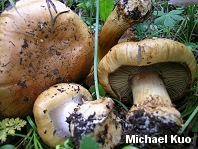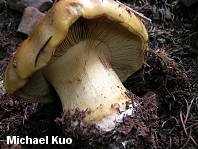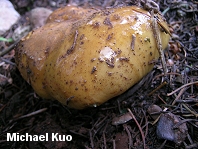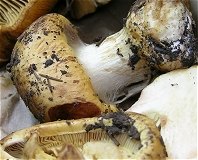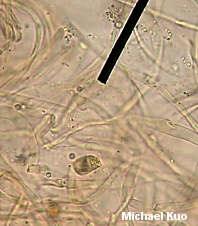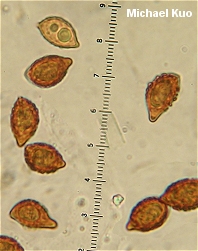| Major Groups > Gilled Mushrooms > Dark-Spored > Cortinarius > Cortinarius elegantio-montanus |

|
Cortinarius elegantio-montanus [Basidiomycetes > Agaricales > Cortinariaceae > Cortinarius ... ] by Michael Kuo Here is a newly described species (Garnica and collaborators, 2011) of Cortinarius from the Rocky Mountains, associated with Engelmann spruce. It belongs to the group centered around the European species Cortinarius elegantior (which appears to be associated primarily with Norway spruce); the other known North American representative is Cortinarius elegantio-occidentalis, which comes from the Pacific Northwest and is associated with various conifers, including spruces, hemlocks, firs, and Douglas-fir. All of these species have sticky, orangish- to yellowish-brown caps and bulbous stems, as well as yellowish young gills, and, under the microscope, large, lemon-shaped spores with coarse ornamentation and a naked, snout-like end. However, Garnica and collaborators were unable to find support for consistent, convincing morphological differences between the DNA-defined species, which means that identification must rely either on DNA data, or on range and distribution (apparently easy enough on the basis of current data, but one wonders what should be done with specimens found between the Rockies and the Cascades). Additional North American elegantior group species may exist, since Garnica and collaborators did not study eastern North American material. Kauffman (1918) described Cortinarius elegantioides, as well as an unnamed "variety" of Cortinarius elegantior, from Michigan, associated with oaks. Kauffman's descriptions appear to match, more or less, the DNA-defined species--although Cortinarius elegantoides has a tardily bitter taste and much larger spores. Moser, McKnight & Ammirati (1995) described Cortinarius elegantior var. americanus on the basis of Wyoming collections made under Engelmann spruce and blue spruce. It differed from the European species, according to the authors, in "yellow veil color, in paler more yellow pileus color lacking olivaceous tinges, and the colors of the context which are yellowish but never deep rhubarb color in the lower part of the stipe" (320). Although they were unable to find support for these morphological differences (see the discussion above), Garnica and collaborators (2011) elevated this variety to species status, and used its type collection as the type collection for Cortinarius elegantio-montanus. Description: Ecology: Mycorrhizal with Engelmann spruce and perhaps with other conifers (all of the collections cited by Garnica and collaborators were made under Engelmann spruce and other conifers, from lodgepole pine to subalpine fir and others, but Englemann spruce was the only common denominator among all collections; my collections were made under Engelmann spruce and subalpine fir); Rocky Mountains from southwest Colorado to at least Wyoming; monsoon season (July and August). Cap: 4-12 cm; convex, becoming broadly convex or nearly flat; sticky when fresh; bald or sometimes finely silky in places; occasionally with a few small, brownish scales (veil remnants) over the center; yellow (when young) to brownish yellow or yellowish brown; the margin long incurved. Gills: Attached to the stem; close; dull yellow at first, becoming cinnamon to rusty brown, sometimes with an olive hint. Stem: 4-7 cm long; up to about 3 cm thick above; more or less equal above a large, rimmed basal bulb; yellow when young, maturing to dull yellow and often discoloring brownish; dry; bald or slightly hairy in places; often with rusty fibrils or a ring zone; veil bright dull yellow, leaving remnants on the edge of the bulb. Flesh: Whitish in the cap to pale yellow in the stem; frequently turning very slowly pinkish to pink in the stem when sliced. Odor and Taste: Odor not distinctive, or pungent and slightly foul. Taste not distinctive. Chemical Reactions: KOH (10%) brownish red on cap surface, pinkish to red or purplish red on flesh in base of stem. On dried specimens, KOH (15-30%) dark red on cap surface, pink to red on bulb surface. Spore Print: Rusty brown. Microscopic Features: Spores 13-15 x 8-9.5 µ; limoniform; coarsely and strongly verrucose; apicular end often snout-like and not ornamented. Pleuro- and cheilocystidia absent; inconspicuous marginal cells occasional. Pileipellis an ixocutis of clamped, ochraceous to pinkish orange (in KOH) elements. REFERENCES: Garnica & Ammirati, 2011. (Moser, McKnight & Ammirati, 1995; Garnica et al., 2011.) Herb. Kuo 08080506, 08140806. This site contains no information about the edibility or toxicity of mushrooms. |
© MushroomExpert.Com |
|
Cite this page as: Kuo, M. (2011, December). Cortinarius elegantio-montanus. Retrieved from the MushroomExpert.Com Web site: http://www.mushroomexpert.com/cortinarius_elegantio-montanus.html |
